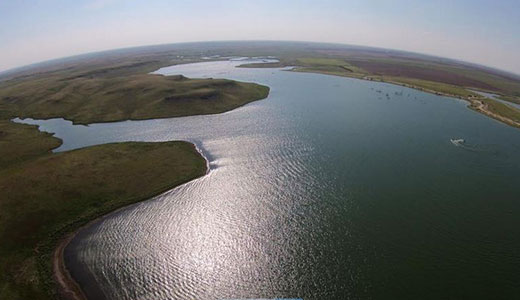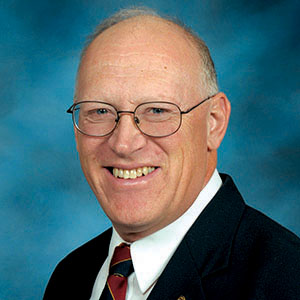
HorseThief Reservoir | Download this photo
Kansas Profile – Now That’s Rural: Audrey Rupp, HorseThief Reservoir
March 2, 2022
By Ron Wilson, director of the Huck Boyd National Institute for Rural Development at Kansas State University
Would you like to go camping on a lakefront property? Then build yourself a lake next door.
That statement might sound overly simplistic, but today we’ll learn about a reservoir that was recently constructed in southwest Kansas. It is serving the outdoor recreation needs of thousands of people in Kansas and beyond.
Last week we met the Jantz family of MJE LLC, which is the company that constructed this project known as HorseThief Reservoir. Audrey Rupp is district manager for HorseThief Reservoir. Gene Webb is HorseThief’s historian.
Audrey grew up at Tribune, studied Tourism and Hospitality at Fort Hays State University and became manager at HorseThief in November 2021. Gene Webb is a lifelong resident of Hodgeman County where the lake is located.
“I’ve hunted and fished in this area since I was 12 years old,” Gene said. “Now I’m 85.”
Gene served on the board of the HorseThief Reservoir Benefit District for many years. “The Corps of Engineers had been interested in the possibility of a dam here back in the 1930s,” Gene said.
In tight budget climates, how would such a project get accomplished? In more recent years, the Pawnee watershed district studied the issue and proposed going to the state to create a tax benefit district that could generate resources for reservoir construction.
“I was on an advisory committee to see if people were willing to support a sales tax to build the lake,” Gene said. In 2004, the proposal was put on the ballot in Hodgeman, Ford, Gray and Finney counties. The proposal passed by more than a 2-1 margin. The Pawnee Watershed District owns the land, which is leased to the HorseThief Benefit District.
In 2009, the 7,200 foot long dam was completed. The reservoir was constructed in a scenic area nine miles west of the rural community of Jetmore, population 770 people. Now, that’s rural.
The reservoir takes its name from a nearby canyon where the old-timers say horse thieves were hung back in frontier days. Here’s my advice: When you come to the reservoir today, bring your own horse….
HorseThief Reservoir is now the largest body of water in southwest Kansas, consisting of 450 acres of water in 1600 acres of prairie. “Everybody said (the lake) would never fill with water,” Audrey said, due to the fickle nature of western Kansas rainfall. “By spring 2010 it was filled to 50% and by July 2016 it was filled to capacity.”
In 2018, an estimated 100,000 visitors came to HorseThief Reservoir from many states. “We have 54 camping sites with utilities and primitive camping sites all over,” Audrey said.
There are boat docks, barbecue sites, horseshoe pits, frisbee golf, windsurfing, an archery range, swimming area, equestrian corrals, hiking and biking trails, a lodge, and a stage and open air pavilion which has hosted a red dirt music festival plus weddings and holiday parties.
There are also five yurts, which sounds like something out of a Dr. Seuss book. These are domelike structures for lodging. A reservoir visitor can opt for primitive camping or go for a yurt with the comforts of home.
A couple of the yurts are fully equipped with running water, refrigerator, stove, microwave, bathrooms, queen beds and more. This is for what some call Glamping – glamorous camping.
Walk-in hunting is allowed for deer, waterfowl, and upland birds. The lake is stocked with walleye, large mouth bass, channel cat, bluegill, sage eye and more. “I’m still an avid fisherman,” Gene said.
There are also special events such as Zombie paintball in the fall, plus a rooster roundup contest and more. “We have a friends group which holds fundraisers with the proceeds going to the reservoir,” Audrey said. “We are actively working on plans for further enhancements to get people here year-round.”
For more information, see www.horsethiefreservoir.com.
Would you like to go camping on a lakefront property? Then build a lake next door. We commend Audrey Rupp, Gene Webb and all those involved with HorseThief Reservoir for making a difference with this community enhancement in outdoor recreation. Let’s go to the lake!
Audio and text files of Kansas Profiles are available at http://www.kansasprofile.com. For more information about the Huck Boyd Institute, interested persons can visit http://www.huckboydinstitute.org.
***
The mission of the Huck Boyd National Institute for Rural Development is to enhance rural development by helping rural people help themselves. The Kansas Profile radio series and columns are produced with assistance from the K-State Research and Extension Department of Communications News Media Services unit. A photo of Ron Wilson is available at http://www.ksre.ksu.edu/news/sty/RonWilson.htm. Audio and text files of Kansas Profiles are available at http://www.kansasprofile.com. For more information about the Huck Boyd Institute, interested persons can visit http://www.huckboydinstitute.org.


